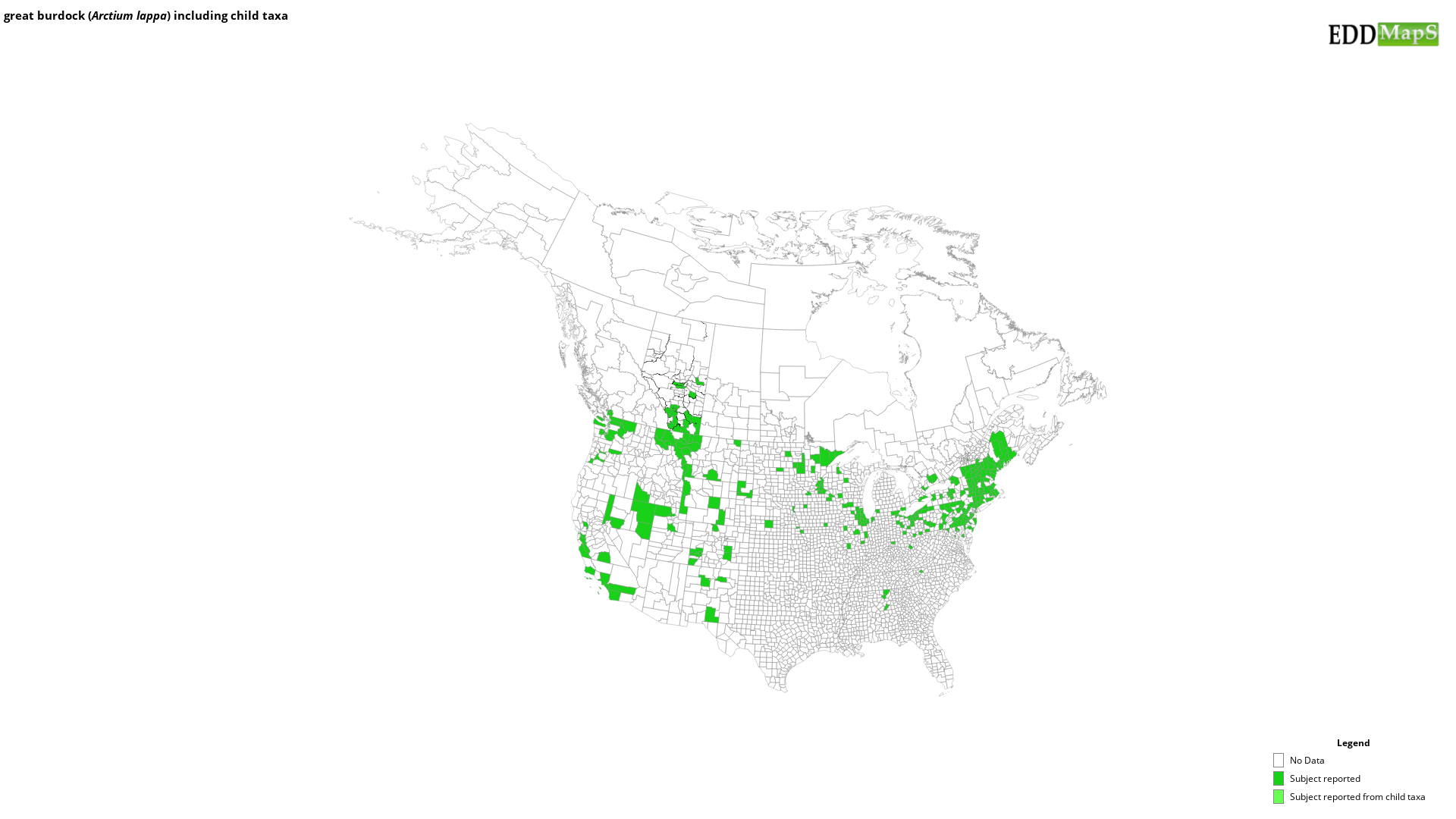great burdock
(Arctium lappa)
This species is Introduced in the United States
Overview:
Great burdock is a biennial herb of the Aster family and is native to temperate areas of Eurasia. It forms a mound of leaves and a slender taproot in the first year of growth and then produces a flowering stalk in the second season. Roots can grow about 1 m long and 2 cm across.2 Even in its native habitats great burdock tends to establish on disturbed ground.3 It flowers during the summer and matures early fall. The flowers are hermaphroditic (having both male and female parts) and are pollinated by bees and butterflies. The hooked barbs of mature flowers attach themselves to the clothing and hair/fur of humans and mammals, facilitating seed dispersal.
Great burdock was used during the Middle Ages as a vegetable and the roots are still favoured in Asian cooking. It has also has long been used as a medicinal plant is widely available in herbal products.
Habitat:
It prefers moist soil but grows on both fertile or clay soils in full sun.
Identification:
Stems: Grow 100-300 cm tall,1 are branched, rough and usually sparsely hairy.3 Stems may be grooved and are green but can become purple-tinged as the plant matures.
Leaves: Are triangular to broadly ovate with cordate bases3 and 25-80 by 20-70 cm with coarsely dentate to almost entire edges.1 Leaves are arranged alternately on 15-36 cm petioles. Leaf surfaces are smooth or thinly grey-hairy towards the outer edges, and green, sparsely short-hairy or hairless in the median.1
Flowers: Are composed of 40+ florets which are purple (occasionally white) and 9-14 mm long.1 Flowers are borne in involucres 25-45 mm in diameter on 2.5-6 cm stems.1 Involucral bracts overlap in many rows of long, lance-shaped, rigid, green bracts with inward hooked tips.3 The flower heads occur in clusters. Seeds are light brown, often dark spotted, and 6-7.5 mm long with a small 2-5 mm pappus bristle.1
Seeds: Seed pods are long 0.5 to 1.5 cm long, constricted between seeds1 and become papery as they mature. Seeds are black and 1-1.5 cm long.
Prevention:
Disturbed sites should be reclaimed with desirable vegetation to prevent burdock establishment. Control of biennial plants such as burdock is best done in the first year of growth/rosette stage or prior to flowering in the bolt stage. The burred seed is easily dispersed via human and animal movement - access to infestations that have gone to seed should be prevented until control work can take place. Additionally, control work of mature plants must prevent seed dispersal.
Control:
Grazing: Cattle are not known to graze burdock. The barbed flower heads can become entangled in livestock hair causing mats or injuries around the eyes. Invasive plants should never be considered as forage.
Mechanical: Rosettes can be hand dug. Mature plants can be cut or dug up prior to flowering.
Chemical: Currently no selective herbicides are registered for use on great burdock. Always check product labels to ensure the herbicide is registered for use on the target plant in Canada by the Pest Management Regulatory Agency. Always read and follow label directions. Consult your local Agricultural Fieldman or Certified Pesticide Dispenser for more information.
Biological: None researched to date.
References
1 Arctium lappa in Flora of North America. www.efloras.org
2 http://en.wikipedia.org/wiki/Arctium_lappa
3 Greater Burdock. Nature Gate. www.luontoportti.com/suomi/en/kukkakasvit/greater-burdock
Selected Images
Maps
EDDMapS Distribution - This map is incomplete and is based only on current site and county level reports made by experts, herbaria, and literature. For more information, visit www.eddmaps.org
State Lists - This map identifies those states that have this species on their invasive species list or law.
Invasive Listing Sources
- Alberta Weed Control Act
- Jil M. Swearingen, Survey of invasive plants occurring on National Park Service lands, 2000-2007
- John Randall, The Nature Conservancy, Survey of TNC Preserves, 1995.
- National Park Service, Mid-Atlantic Exotic Plant Management Team Invasive Plant List
- WeedUS - Database of Plants Invading Natural Areas in the United States
Taxonomic Rank
| Domain: Eukarya |
| Kingdom: Plantae |
| Phylum: Magnoliophyta |
| Class: Magnoliopsida |
| Superorder: Asteranae |
| Order: Asterales |
| Family: Asteraceae |
| Subfamily: Carduoideae |
| Tribe: Cardueae |
| Genus: Arctium |
| Arctium lappa |
References
Common Name Reference: Weed Science Society of America Common Names List
Scientific Name Reference: USDA, NRCS. 2010. The PLANTS Database. National Plant Data Center, Baton Rouge, LA, USA.


